new posts in all blogs
Viewing: Blog Posts Tagged with: Lives in Letters, Most Recent at Top [Help]
Results 1 - 11 of 11
How to use this Page
You are viewing the most recent posts tagged with the words: Lives in Letters in the JacketFlap blog reader. What is a tag? Think of a tag as a keyword or category label. Tags can both help you find posts on JacketFlap.com as well as provide an easy way for you to "remember" and classify posts for later recall. Try adding a tag yourself by clicking "Add a tag" below a post's header. Scroll down through the list of Recent Posts in the left column and click on a post title that sounds interesting. You can view all posts from a specific blog by clicking the Blog name in the right column, or you can click a 'More Posts from this Blog' link in any individual post.
Felice Arena - Australian author and illustrator of Sally and Dave, A Slug Story - celebrates his birthday today! Felice (pronounced Fe-LEE-chay), will be visiting the East Coast of the U.S. during the next week. If you haven't already seen the video where he reads aloud from this great tongue-twister of a picture book, don't miss it. You can view it on his biography page found on the Kane/Miller author's pages. Cheers!

By:
Sondra Santos LaBrie,
on 2/19/2008
Blog:
Happy Healthy Hip Parenting
(
Login to Add to MyJacketFlap)
JacketFlap tags:
bine brandle,
anette bley,
anniversary,
illustrators,
website of the week,
bine brandle,
anette bley,
Sally and Dave,
calendar,
authors,
illustrators,
anniversary,
calendar,
Sally and Dave,
website of the week,
Add a tag
We've been making some minor changes to our website over the last few weeks - some of which may go unnoticed - such as changing the Conference Schedule to a more comprehensive and - we think - more useful Calendar.
We've changed the content on the What's New page to include the full text of the latest Kane/Miller book mentioned - Sally & Dave is featured this week - and we will continue to update this page with the latest reviews.
We have added photos to a few of the biography pages of our authors and illustrators, including Anette Bley and Bine Brändle.

You'll also see that many authors and illustrators have allowed us to include their birth dates on the Calendar, giving us more reasons to celebrate - and promote their work!
As always, feedback, comments and suggestions are welcome. If you find a feature on our website that could use a little tweaking, we'd like to know about it. We want our site to be as helpful and user-friendly as possible so please let me know what might not be working for you.
Speaking of updates, you'll see that there's a new Kane/Miller widget on our blog which lists the most recent posts. We're always looking for more creative ways to reach our readers and we hope you enjoy the modifications.

By:
Sondra Santos LaBrie,
on 2/1/2008
Blog:
Happy Healthy Hip Parenting
(
Login to Add to MyJacketFlap)
JacketFlap tags:
librarians,
education,
interactive,
teachers,
March 2008,
Sally and Dave,
play pages,
classroom,
Jukebox,
Sally and Dave,
play pages,
March 2008,
classroom,
Jukebox,
Add a tag
I'm pleased to announce that two of the four new Play Pages for our Spring 2008 titles are now available on line.
Word searches for both Jukebox and Sally and Dave can now be printed from your computer to create a more interactive way to use these two books, either in the classroom, or at home.
More Play Pages can be found on our website for Benny, Bobbie Dazzler, Half of an Elephant, Jack Russell: Dog Detective, Kali and the Rat Snake, Singing Shijimi Clams, and The Story of Cherry the Pig.

by Utako Yamada
Over the next few weeks, we'll also be updating the site to include Play Pages for Hannah Duck and No! That's Wrong!

Today is the first anniversary of this blog, and I'm so pleased to have made it a whole year. There were times -- after I went back to work, after I started spending more weekends out and about and more time getting together with people I love, after the visitors started showing up on my doorstep to stay a day or two or six -- that I thought something would have to give and most likely it would be the blog. But I've given myself permission to lighten up, post only when I want to and what I want to, and that's made a huge difference and allowed me to keep going. You can't be all-or-nothing about blogging, or eventually it will be nothing.
So, I'll take a moment to reflect on the first year of blogging, and then I'll talk about my Anniversary Contest. Bear with me, the contest info will be just a few lines below....
Highlights of my blogging year:
- Coming up with my blog name, one that was perfectly suited to me.
- Being welcomed to the blogging world by Jen Robinson.
- Buying two of Leila's excellent t-shirts.
- Watching Miss Erin and Little Willow crush the competition in my Great Antagonists of Children's Literature and Great Passages of Children's Literature contests.
- Laughing and laughing and laughing over MotherReader's posts.
- Remembering to treat myself well thanks to Robin.
- Remembering to be grateful thanks to Jules and Eisha.
- Being able to count on Michele for very smart commentary.
- Learning how to write fibs from Greg.
- Working as a judge for the Cybils YA category.
- Being contacted by a reporter about my postcard series.
- Getting to know Kelly, Liz, Heather, Susan, Lady S, Elaine, and so many others out there blogging.
- Finding treasures like the picture at the top of this post and the picture at the bottom.
- Every single comment and email that you've sent my way. It's meant so much to know when I've captured your interest, introduced you to a poet you'd never heard of, made you think or laugh, or inspired you to contribute to one of my lists. It's also meant a lot just to know you've been reading. Yes, you.
And the po
I found a quick series of postcards from Hershey Pennsylvania in my travels today, and being inclined towards chocolate, I thought these would be fun to talk about.
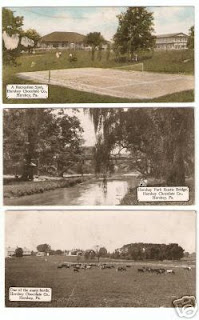 Postcards
Postcards
Recreation Spot
Rustic Bridge
Cow Herd
Hershey Chocolate Co.
Hershey, Pa.
Chi & Carbondale R.P.O.
October - November, 1909
Addressed to:
Mrs. D. A-
Streator, Ill.
Messages:
October, 1909
Dear Mother + Father
Did not get my ??
off until to-day
so do not know
whether you will
get it on time or
not. Am O.K. Having
bad weather but every
thing is fine so far.
Ed
November 14, 1909
Glad everything
is O.K. at home.
Same here. Tell me
if father's name goes
up. Will write to-night.
Ed.
November 22, 1909
Got your letter
this A.M. Glad
everything is O.K.
Do not send any
money. Don't need
it and I will stay
until Xmas.
Ed.
Notes:I'll talk about the chocolate in a bit, but first a few things about these cards.
These were all postmarked from the Chicago-Carbondale
Railway Post Office (RPO). The RPO was an actual railway car or series of cars that functioned as a permanent but mobile post office. The car had a slot where you could leave letters like in a mailbox, and a sorting set-up inside including all necessary staff. The RPO system existed for 113 years in the U.S. (from 1864 to 1977) but was ultimately replaced by air and ground transport of U.S. mail.
These postcards then, even though they show Hershey, PA on the front, were sent from somewhere between Carbondale, IL (Southern Illinois) and Chicago. It could have been anywhere along that line, because Ed's parents were from a mining town in rural Northern Illinois, that sits between Carbondale and Chicago.
Ed sounds to me like a college Freshman writing home to reassure his parents. For the sake of argument, I'm guessing he was at
Southern Illinois University in Carbondale. His parents wanted him home for Thanksgiving, and were going to send him money to make the trip, but Ed told them no, he'd stay at school until Christmas. Not that I know any of this -- Ed's not terribly chatty, but perhaps his letters had more substance than his postcards.
Okay, onto the important matters of chocolate.
First, when did Ed go to Hershey? My guess, the summer before he started at college. It was his last family trip with the parents and the little brothers and sisters. Hershey was still very new, and spectacular, so it must have been quite a trip.
Here's what an historical marker in the center of Hershey says about the town:
Hershey
Model industrial town and noted tourism destination established in 1903 and named for its founder, Milton S. Hershey (1857 - 1945). Hershey's companies developed housing, recreation, education and cultural facilities, financial institutions, public utilities, a transit system, and the world's largest chocolate factory that opened in June, 1905.
And here's more from the Hershey.com website:
It was here, surrounded by some of America's most productive dairy farms, that Milton S. Hershey opened the world's first modern chocolate factory, and built the "model town" to provide employees and their families with an attractive place to live, work, and play. In 1907, he opened "Hershey Park" for the recreation and entertainment of the workers and their families. He also built a zoo, now known as ZooAmerica. During the Depression, his "Great Building Campaign" created jobs and a stadium, sports arena, community center with an elegant theater, and a Mediterranean-inspired hotel-The Hotel Hershey.
Mr. Hershey's proudest accomplishment was the founding of the Hershey Industrial School for Orphan Boys in 1909, and the establishment of a trust that would provide funding for the institution.
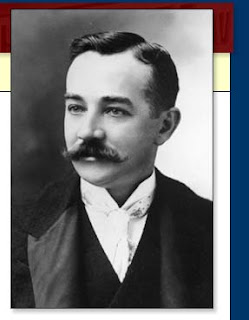
Did you know that Milton Hershey failed in the candy business THREE times (in Philadelphia, Chicago and New York) before he finally made a go of it?
This brief story about Milton Hershey is worth reading, especially the Model Town and Legacy sections, where you can learn more about Hershey's methods for building a community for his employees, keeping folks working through the depression, and taking care of children in need. It's good stuff.
And now that I've taken the time to make this wonderful chocolate tour, I may just have to book a trip to the Hershey
Chocolate Spa. It's only 2 short hours from my home. Oh my.
Oh my. Oh my....
How interesting is this postcard?
I did my very best to translate the Swedish word by word into something that resembles English. (It actually took me a while to figure out that it was Swedish rather than German, Dutch, etc. -- thank goodness for the internet!) If anyone out there can read Swedish, and wants to take a look at the original in somewhat less-than-pristine handwriting, I'd love to learn how bad my translation actually is. Plus, I have a few blanks to fill in.
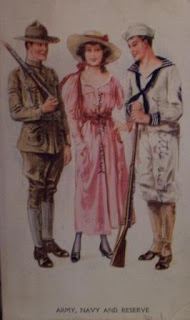 Postcard
Postcard
Army, Navy and Reserve
Washington, D.C.
September 21, 1918
Addressed to
Mrs. Enack C-
Jamestown, NY
Notes written sideways on each of the people on front:
Navy – “your little brother”
Girl – “my little reserve”
Army – “your little hubbie”
Message on back:Fredriksburg Virginia
Torsdag middag (Thursday midday)
We went
to Richmond this morning.
We went out for a stroll
through town, we found it
pleasant. Oh I felt proper
elegant. So we were not sad.
We came into Washington
around 3 ??. I hope
we go to see the President. I was not
sad for ????. XXX
??? but we are here in
Washington we shall
eat dinner here.
I wish you were here now.
Notes:
Take a look at the notes written on the front of the postcard. I believe that "my little reserve" is the woman to whom this is addressed. I believe that "your little hubby" is the author of this postcard, and is married to the addressee.
Isn't that just adorable?
It's hard to tell from this message, especially my translation, but I'd guess that the author of this postcard was in the military, and headed off to serve during "The Great War." You can check out a
war timeline here, and see what was going on in 1918 when this postcard was sent.
I really have to wonder if I got the translation right. Why so much "sadness" in this message? Even though he's saying "not sad" it makes me curious.
One more note... I don't know why it took me so long to figure out this was Swedish. It was sent to
Jamestown, where there is a large Swedish population. And I knew that, because my brother has Swedish in-law family in that area. Of course,
this lovely and funny lady was born in Jamestown, but is NOT Swedish.
I spent an hour sorting through my postcards tonight, trying to get organized to present the long-promised family postcards of the attorney from a few weeks ago. I'm now organized, and I realize that getting these postcards all photographed and ready to post is going to take an afternoon. Maybe the coming holiday weekend will afford me the time. I promise it will be worth it when all is said and done.
Meantime, here's a cute one that I've been hanging onto for a while. See what you think....
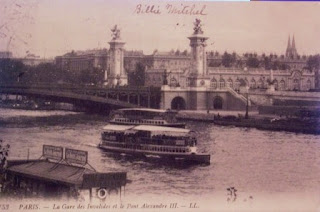 Postcard
PostcardLa Gare des Invalides
et le Pont Alexandre III
Paris, France
December 10, 1908
Addressed to
Mr. & Mrs. James D.
Sidney, New York
U. S. America
So pleasant to hear from
H. that you have
arrived home safely --
Am very happy to tell you
that I am engaged to our
English friend. Altho' no
doubt you have heard it. Am
only at No. 30 for half time now.
My very best wishes to you both.
Billie M.
Notes:
The postmark is from the Grand Hotel in Paris, which was built sometime around 1870, and like its counterparts in other parts of Europe, is still today a truly impressive hotel structure.
In case you're in the mood for a quick summary of all things Paris,
here's a link for you. I found nothing in particular about the hotel, which was a disappointment.
I like that Billie addressed the card to U. S. America.
I also like that her name was "Billie." You may be able to see from the photo that she signed the front of the card too.
La Gare des Invalids -
history of the original design and construction at Wikipedia. Napoleon Bonaparte is buried there. Many other military leaders are buried there as well, though some have just their hearts buried there, which I find a little disturbing. A large esplanade in the front makes the surrounding structures seem like a palace.
Pont Alexandre III -
brief history of the bridge at Wikipedia. Also, here are some
great pictures from other postcards. These will give you a better sense of how pretty the bridge is, and there's a bit of history at the bottom there too.
I liked this message, especially the part about being engaged to "our English friend," because something about the language makes me believe that Billie is truly happy about it. I think it's the use of "our English friend" and the shortened version of "although" that make me believe that, though I can't put my finger on why.
.
I'm not sure what "Am only at No. 30 for half time now" means. Well, I understand it in a generic sense, in that Billie must have been lodging at #30 X street, and now she is only there half the time. But why? Where does she go the other half of the time?
I know I promised to post more postcards from the District Attorney but in a cleaning frenzy last week I put my camera somewhere very safe and now I can't remember where that is. So I've fallen back on an older card that I've had ready to post for months. Wish me luck finding the camera, and all the other things I hid in the last minutes of "cleaning."
This card struck me both for the picture on the front, and the timing and message on the back.
 Postcard
Postcard
Enlisted Men’s Barracks,
Camp Lejeune, Marine Base
New River, NC Marine Barracks
October 15, 1943
Addressed to
Mr. & Mrs. Howard S-
Slatington, Pa.
Hi.
I’m sure enjoying
myself. It is a
beautiful camp. The
Hostess House where I’m
staying is 3 blocks from
Marvin’s barracks.
Marvin said
“hello.” Ellen
Notes:The first thing that struck me about this message is the date. Right in the middle of World War II. Ellen's message is so cheerful, almost jarringly cheerful, considering all that was happening at the time. Of course, cheerful optimism was a standard of the time.
Here's some
World War II timeline information for the months leading up to Ellen's postcard. A few highlights, if you'll excuse the term:
- Battle of Kursk
- Battle of Kula Gulf
- Allied invasion of Sicily
- Battle of Vella Gulf
- Bombing of Hamburg
- Firestorm in Hamburg
- Allied invasion of Italy
- Italy declares war on Germany
What was a "hostess house?" Quite simply, a hostess house is a hotel on a military base. Luckily, I found this
glossary of Marine slang to help me out there. I must add that the glossary was much more polite than I expected. I may have to searching for a more comprehensive glossary to get some of the fun acronyms and catch phrases. For now, I enjoyed seeing the definition for
JOB (junk on the bunk), which is field gear and uniforms laid out for inspection and
gungy, which means enthusiastic, or I imagine, gung-ho.
So, my guess is that Ellen is Marvin's wife, and she was staying at the Hostess House while Marvin was in some sort of training at Camp Lejeune. The postcard is to Marvin's parents, and it's cheerful because 1) Ellen is a naturally cheerful sort; 2) Marvin is not in Europe or the Pacific, but relatively safe stateside right at the moment; 3) Ellen gets to see Marvin regularly; 4) Ellen doesn't want Marvin's parents to worry about where Marvin is going next.
That's my theory and I'm sticking to it.
Next week I really will try to get those family postcards up here.
I'm sitting here with 6 postcards in hand, all sent to the same person, or perhaps to a father and son, between about 1925 and 1935. No time to post them all tonight, but I'll get them all up by next week so you can see how the story evolves. It's very interesting -- the recipient went from attorney, to city solicitor, to district attorney over the course of the postcards, and the messages, though addressed to this guy's place of work, have some fun irreverence in them.
"The day was perfect beginning with the goats..."
For tonight, I'm starting with this one from 1935. There's no need to post a picture, as this is one of those plain beige penny postcards from the post office. Anyway, the message paints a fun picture itself.
Postcard
Northampton, Mass.
May 19, 1935
Addressed to
Mr. Philip C.
Springfield, Mass.
Message:
May 18, 1935
12:01 A.M.
Dear Phil,
...We're terribly
sorry about rushing
off the way we
did but rules are
rules.
...The day was
perfect beginning
with the goats
and ending with
sweet dreams.
...Thanks again,
.............Margie + Esther
P.S. Two good-nights.
.............M. + E.
Notes:
I'm betting that Margie and Esther were rushing away to get back to their dorm at
Smith College, before breaking curfew. Notice that Margie wrote the time as 12:01 -- they must have barely made it back. A few years later, in 1941, the women of Smith would get the curfew rules changed:
Smith was a safe haven, far from the war raging in Europe. Maids kept the dormitories clean and the beds made, and the King’s men (a reference to the maintenance staff headed by George King) kept the grass immaculate and the walkways cleared in winter. The prevailing issue for students was getting the college to loosen its curfew, an effort they won in October when the college granted “late permissions,” allowing first-year students to stay out as late as 1 a.m. on four Saturdays per semester.
So, about those goats... I wonder if Phil took the girls to the first ever
Dairy Classic (now Livestock Classic) at Mass Aggie (now UMass)? There were certainly goats there! And perhaps the "sweet dreams" reference means they got ice cream at the Dairy Classic. Well, that's my theory, and I'm sticking to it!
A popular event at the Little International Livestock Show ... was the co-ed milking contest. In this event, sorority pledges, hand picked for their lack of experience, would compete to milk a cow and fill up a test tube in the shortest amount of time. The winner of the contest received the title of "Girl with the Most Pull on Campus."
Ummmm, yeah.... 'nuff said.
But tell me, when you think about the girls and the goats, which of these was Margie and which was Esther?


Okay, more about Phil, or Phil and his dad, next week. For now, sweet dreams.
I'm happy to report that my mom is supporting my habit -- she hunted down over a dozen postcards for me, most of which are going to be lots of fun to post. Here's the first, from a part of Maine I'm pretty familiar with.
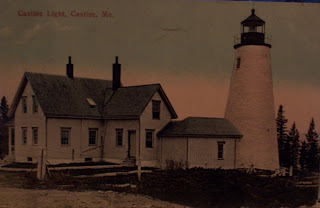 Postcard
PostcardCastine Light
Castine, Me.
August 5, 1912
Addressed to
Miss Bernice A-
Agawam, Mass.
.
Castine, Maine. Aug. 5th 1912.
There are two little girls that
now live in this house. They are
about ten and twelve years old. Their
father has been here for a good many years
stationed at a light on an island so
that the girls had never attended school
until last winter. They just love it and do
so much enjoy the winters in this very
quiet little town. It must seem lively
after living on a light house island. We
like it here ourselves. Lovingly,
Aunt Florence
Notes:
I can't help but be intrigued by a time when young boys only went to school in the winter because they were busy working the farm the rest of the year, or when young girls only went to school in the winter because they were living on a lighthouse island the rest of the year!
Castine is an incredibly interesting small town on Penobscot Bay in Maine. It was settled by Europeans before Plymouth; it changed hands and names many times over the following two centuries; it was a significant battleground during the Revolutionary War and saw the battle that earned Paul Revere his court martial. (Which by the way was the worst Naval disaster for America up to Pearl Harbor.) For over 60 years it has been the home of the
Maine Maritime Academy. And it has become a vacation and retreat destination for many who think that Winters should be cold and Summers nights should be chilly. (Like me!)
Of course anyone who's spent time driving along the New England Coast (or many other coastlines, for that matter) has seen their share of lighthouses. But aside from being pretty, and having a the most wonderful soulful sound in the fog, what else makes lighthouses so interesting? Here's what
Wikipedia has to say about the creation of lighthouses, with an added note from me:
Most of the lighthouses in the United States have been built and maintained by the Coast Guard since 1939, its predecessor the United States Lighthouse Service from 1910-1939 and its predecessor the United States Lighthouse Board from 1852-1910. Before the Lighthouse Board was established, local collectors of customs were responsible for lighthouses under Stephen Pleasonton. (NB, Pleasonton was Department of Treasury.)

For a little more information on this particular lighthouse, check out
this page, and scroll down to Dice Head Light. Or better still, go directly to
this page.
It seems a peculiar thing to raise a family at a lighthouse. I did some web searching to learn more about what that life was like, and found a few good descriptions that might help you understand about the two girls mentioned in the postcard.
First, this account of one family at a lighthouse on
Rock Island, Michigan, explains the isolation, how some families chose to live apart, and the concept of "winter break."
The first two Betts children (Wm. Jr. and Jane) were born right at the lighthouse without the assistance of doctor, nurse, or neighbor, the next seven children were born on Washington Island. Records indicate Emily Betts, assistant keeper, and family continued to live at the Lighthouse during the navigational season. It is not clear in which year lighthouse families began living and using Washington Island as their primary residence. Then, children schooled during the year, with families joining the keeper on Rock Island during summer breaks, and the keeper joining his family on Washington Island when shipping stopped at the close of the navigational season - Dec. 15 through April 1.
On
Thatcher Island, in Rockport, Massachusetts, they had a teacher on the island for a moment:
There were seven children living at Thacher in the early 1900s. The state refused to build a school on the island, but they finally agreed to pay a teacher to live there. The teacher, a young woman, didn't stay at the island very long. She met and subsequently married Edwin Tarr, son of the keeper and an assistant keeper himself. The couple moved to Boston where Edwin served as keeper of the Long Island Head Lighthouse. After that, most of the children boarded on the mainland during the week so they could attend school.
The kids on
Nash Island, in Addison, Maine fared a little better:
For a while, there were enough children living on the island for a small school to be put in operation with a teacher from the mainland. When they reached high school age the children boarded and attended school in Jonesport.
I searched and searched but wasn't able to find out who the keeper was at this light in Castine in 1912. But I can imagine the two young girls, going completely and utterly stir-crazy for 7 months out of the year, and then suddenly set free in the "lively" town of Castine. They must have been so grateful just to go to school -- can you imagine?
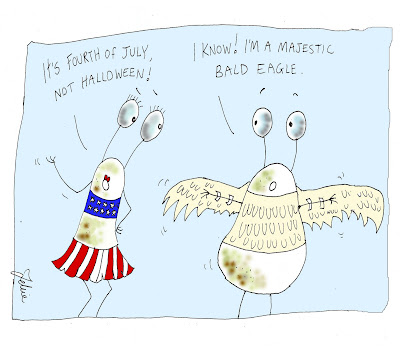

 Postcards
Postcards Did you know that Milton Hershey failed in the candy business THREE times (in Philadelphia, Chicago and New York) before he finally made a go of it? This brief story about Milton Hershey is worth reading, especially the Model Town and Legacy sections, where you can learn more about Hershey's methods for building a community for his employees, keeping folks working through the depression, and taking care of children in need. It's good stuff.
Did you know that Milton Hershey failed in the candy business THREE times (in Philadelphia, Chicago and New York) before he finally made a go of it? This brief story about Milton Hershey is worth reading, especially the Model Town and Legacy sections, where you can learn more about Hershey's methods for building a community for his employees, keeping folks working through the depression, and taking care of children in need. It's good stuff. Postcard
Postcard Postcard
Postcard


Great photo!